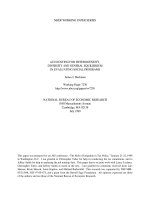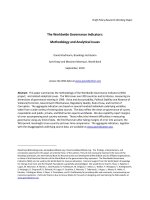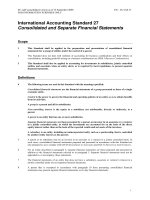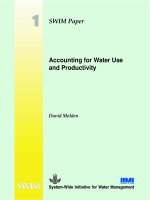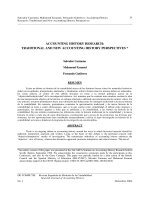business accounting volume 4 advanced and analytical
Bạn đang xem bản rút gọn của tài liệu. Xem và tải ngay bản đầy đủ của tài liệu tại đây (21.38 MB, 487 trang )
BUSINESS
ACCOUNTING
Harold
Dudley Greeley, C.P.A.,
Editor
Volume
I—Theory
of Accounts
By
Harold Dudley Greeley
II—
Constructive Accounting
By
George E. Bennett
III
—Cost
Accounting
By DeWitt
Carl Eggleston
IV
—
Advanced
and Analytical
Accounting
By
Henry C.
Cox
V—Illustrative
Accounting
Problems
By Charles
F.
Rittenhouse
and
Harold Dudley
Greeley
Business
Accounting
VOLUME IV
ADVANCED
AND
ANALYTICAL
ACCOUNTING
By
HENRY
C GOX
Certified
Public
Accountant;
Comptroller,
Columbia
Graphophone
Manufacturing
Company;
Member
Ameri-
can
Institute
of Accountants;
Formerly,
Instructor
of
Accounting, New
York University,
School of
Commerce
Third Printing
NEW YORK
THE
RONALD
PRESS
COMPANY
1921
400G9
Copyright,
1920,
by
The
Ronald
Pkess
Compaiti
All
Rights
Reserved
Bus.
Admin,
Llbraiy
"-
HF
EDITORIAL
PREFACE \1
.
4
Ten
years ago
almost any
contribution
to
the liter-
ature
of
accountancy
would
have
been welcomed.
Today,
however, with the
increasing
number of excel-
lent
publications, it is
incumbent
upon
one
who puts
forth a
new accounting work
to
justify
his action.
Much
more is it necessary to
explain
the
publication
of a set of accounting
books. Hence
it
is desirable to
state
at
the outset the purpose of
"Business Account-
ing" and to outline its scope
and
general
methods
of
presentation.
While many
books have
been published
on account-
ing topics,
in almost every case they are unrelated vol-
umes. In some
few instances,
a
volume
on accounting
has logically
followed another by
the same author, but
with these
few
exceptions
every
one
published
has been
written
without connection
with,
or adjustment to, any
of
those
already
existing. Under these conditions,
the
student
of
accounting,
to
get
any connected and
logical
knowledge of
his subject, must find one of his
books
here, another
there,
a
third somewhere else, and
bridge
over the
gaps
between
them as best he may.
The proc-
ess
is
difficult, and
the accounting
knowledge
he
obtains
is not always well co-ordinated and
logically
developed.
The volumes of "Business Accounting" are
intended
to meet this
situation.
They cannot,
it
is
true,
provide
a
course
of
study
in
the
sense that
prescribed
readings
are
recommended,
written
answers to
questions
required,
and personal instruction given.
Neither
do
they
cou-
iii
iv
EDITORIAL
PREFACE
stitute an
encyclopaedia
of
unconnected
and isolated
articles.
Rather
are
they an
attempt
to present in
simple,
non-technical
language
the
basic principles
of
account-keeping
and
their
application
to
various
lines
of business,
together
with
general directions for prepar-
ing,
analyzing, and
interpreting
accounting statements.
One
who starts at the
beginning of Volume
I and
works
faithfully through to
the end of
Volume IV,
and
then
solves the
problems and
examines the
solutions of
Volume
V, should acquire some real
understanding
of
the
theory and practice
of accounts
—a
knowledge
that,
supplemented by experience, should
enable him success-
fully
to stand the test
of
practical work
in any
ordinary
business
office
and
furnish
a
foundation for
going
as
much
further into the
study of
accountancy
as
he may
desire.
It may
be
noted in
passing that the
volumes
of
"Business Accounting" have been indexed in such
a
way
as
to provide
many
of the
features of an encyclo-
paedia, so that the person desiring the
practice
on
a
particular
point or
accounting
ideas
of suggestive
value
in particular lines
of industry will be able to
use the set
to
advantage.
Taking up the
volumes of the
set
in
order—
Volume
I
presents the fundamental principles of account-keep-
ing and statement preparation.
Upon these
basic
prin-
ciples all systems
of
account
are built.
Volume II
ex-
plains
the principles governing the development of
the
simple
accounting
procedures described
in
Volume
I
to
meet the
needs of
more
complicated and
more
exten-
sive
systems of financial accounting. Volume III
ex-
plains
in
much
the
same way how
the
basic principles
EDITORIAL
PREFACE v
have
been applied
to
factory or cost
accounting.
Hav-
ing thus traced the fundamental
principles
into more
elaborate financial
and cost accounting
procedures, Vol-
ume IV treats accounting
principles
and practices
which
are more advanced
than the basic
ones
described
in Volume
I.
These
advanced principles
are
in most
cases
subject to
differences
of opinion,
as to
their
nature
or application,
among persons
quahfied
to deal
with
them,
and it
is
for this
reason
that their discussion is
confined
to
Volume
IV.
Supplementing
the
illustra-
tions of accounting principles and statement
prepara-
tion, there
follows in
Volume
IV
a
practical discussion
of
the methods of verifying
accounts and
statements
and
of
their
interpretation
and analysis.
The set closes with
Volimie V,
which
gives
a
num-
ber
of
problems of
a
practical
nature,
together
with
their solutions.
The working of these
problems
will
not
only
clarify
the reader's
ideas but
in
many cases
will
provide models upon which he can
base
accounting
procedures
and
build statements to
meet concrete situa-
tions arising in his own work.
The readers
to
whom
this
set
will appeal
most
strongly
may be divided roughly into two classes. There
will be, on the one hand, business and
professional
men,
bankers, office managers, and
other
executives who
feel
the need of understanding
in a
general
way
the methods
of modem account-keeping and statement
preparation.
There
can hardly be excuse nowadays for
them
to
con-
sider bookkeeping methods
and
accounting
statements
as
too complicated
to
understand
or
of
such slight im-
portance as to
merit
no
attention. They need
a
grasp
of the
subject
so that
they may judge
for themselves
\-i
EDITORIAL PREFACE
whether
bookkeepers and
other persons
who
keep
ac-
counts for
them and render
statements
to
them are
giving
information which
is
accurate,
adequate, and
presented in
the most intelligible form.
The entire
tendency of
modern business and civic life
is toward
more
exact accounting, of
which the
accounting
re-
quirements
of
the
present income tax legislation are
but
one
indication. Any
person having substantial
inter-
ests at
stake
should
be
able to appraise intelligently
the
stewardship of those
to whom his
interests are in-
trusted and the
volumes of
"Business Accounting"
will
give
him
the
technical
information
this demands.
The other
class of
persons to
whom
"Business Ac-
counting"
will appeal is
composed of those whose duty
it
is to keep
accounts and to prepare statements.
They
should
find in this set an
inspiration and
an
aid to
more
intensive study,
which
in
turn will result in improved
accounting ability and an
enhanced wage.
The careful
and intelligent use of these
books will lead
beyond ques-
tion to increased
power of service
to employer and com-
munity.
Harold
Dudley
Greeley,
Editor, Business
Accounting
Set.
New
York
City,
April
1,
1920
PREFACE
The prc*'»^at
volume
is
the fourth
of
a series of
five
volumes on
^f.
counting. It
therefore
necessarily
differs
from an inaependent volume on
advanced
accounting,
inasmuch as
it is not a complete
treatise in itself. It
does,
however, give the reader who
has covered
the
de-
velopment of the
subject of accounting
in the
three pre-
ceding
volumes or in other equivalent
volumes
a sys-
tematic
and
connected presentation of
the subject
to a
point
well
beyond
the
elementary
and
up
to
and through
an
advanced stage
of
accountancy.
Following the presentation
of accounting theory
and
bookkeeping technique
which is given
in
the three
preceding
volumes, it is hoped
that
this book will find
some
favor in
its attempt
to
develop these subjects to
the
more
advanced phases.
In
addition, it takes
up
some
matters
which
are
not touched upon in the preced-
ing
volumes.
Among these
latter
will
be
found
a some-
what
detailed consideration of the highly
technical sub-
ject
of
consolidated balance sheets, to
which three
chap-
ters
are
devoted. A
number
of
chapters contain
illus-
trative
bookkeeping
entries
covering
the
transactions
peculiar
to
corporation
accounting,
such
as
those
involv-
ing
capital stock, surplus,
dividends, and
sinking funds.
The
author trusts that
the book will
find its place
in
accounting
literature, and
that it
will
prove helpful.
Henry
C. Cox
Bridgeport, Conn.,
April
1,
1920.
ox
CONTENTS
Pa*:t
I—
Adjusting and Closing
Problems
Chapter
"^
Page
I The
Scope
of
Advanced Accounting
3
1.
Elementary
and Advanced Accounting
2.
Problems
of Advanced Accounting
3.
Adjusting Entries
4.
Closing
Entries
5.
The
Valuation of Assets
and
Verification
of Lia-
bilities
6.
Bonds
and Other
Securities
7.
Annuities
and Sinking
Fund
Operations
8.
Sinking
Fund
Investments
9.
Preparation
of
Financial Statements
II
Deferred
Debits 12
1.
Closing
Problems
2.
Accrued
Interest
vs. Interest Accrued
3.
Kinds
of
Prepaid
Expenses
4.
Accounting
for
Prepaid
Expenses
5.
Organization
Expenses
6.
Advertising
7.
Royalties
8.
Accrued
Income
9.
Cash
Methods
of
Handling
Accounts
10.
Accounting
for
Accrued
Income
11.
Dividends
Receivable
III
Deferred
Credits
26
1.
Liabilities
Accrued
2. Expense
Accrued
3.
Accounting
for Expense
Accrued
4.
Taxes
Accrued
5.
Deferred
Income
6.
Accounting
for
Deferred
Income
IV
Profit
Determination
33
1,
Definition
of
Profit
3.
Capital
Profit
3.
Gross
or
Manufacturing
Profit
4.
Profit on
Work
in
Process
5.
Profit on
Finished Cioods
6.
Interdepartmental
Profits
X
CONTENTS
Chapter
Page
7.
Net
Profit
8.
Problems of Profit Determination
9.
Appraisal of
Asset Values
10.
Aspects of Value
11.
Basis of
Valuation
^
12. Sources of
Data
for
Valuation
-
13.
Capital vs.
Revenue Expenditures
14.
Maintenance
—Repairs, Renewals, and
Replace-
ments
«
15.
Effect
of Depreciation
on
Profit
16.
Efi'cct of
Appreciation on Profit
17.
Metliods of
Determining
Profit
or Loss
18. Summary of
Principles of Profit Determination
V
Corporate Dividends
55
1.
Definition
2. Sources
of Dividends
3.
Profits
Available for Dividends
4. Revenue
Expenditures
and
Capital
Expenditures
5.
Declaration of
Dividends
6. Forcing
Declaration of Dividends
7.
Participation in
Dividends
8.
Status of
Declared Dividends
9. To
Whom
Paid
10. Notice of
Dividends
11.
Payment of
Dividends
12. Form
of Payment
13.
Stock Dividends
14.
Bond
Dividends
15.
Scrip
Dividends
16.
Property
Dividends
VI
Accounting for Dividends
77
1.
Procedure for Payment
of
Dividends
2.
Dividend Sheet or
Book
3.
Entries for
Cash
Dividends
4.
Entries for Dividends Paid
with
Borrowed
Money
5. Entries for Scrip Dividends
6.
Entries for Special and
Interim
Dividends
7.
Entries for Dividends
Applied
to
Stock Subscrip-
tions
8. Entries for
Cumulative
Dividends
9.
Entries for Stock
Dividends
10.
Entries
for
Bond Dividends
11.
Entries for
Property
Dividends
12.
Illegal Dividends
VII Surplus
—
Nature
and
Sources
. ,
, „
, 95
1.
Definition and
Nature
of
Surplus
2.
Sources of
Surplus
CONTENTS
xi
Chapter
Page
3. Surplus and Undivided
Profits
Account
4. Entries to Surplus
Account
5.
Surplus from Sale of
Assets
6.
Surplus
and the Revaluation
of
Assets
7.
Accounting for
Surplus
and
Reserves
8. Effect on Balance
Sheet
VIII Reserves and
Funds
104
1.
Definition and
Nature of Reserve
2. Balance Sheet Treatment
of
Reserves
3.
Reserves
vs.
Funds
4.
Relation Between
Reserve
and Fund
5. Secret
Reserves
6.
Further Classification
of Reserves
7.
Operation of True Reserve
Accounts
8. Operation of
Valuation
Reserve
Accounts
Part II
—Bonds, Capital Stock, and
Depreciation
IX
Bonds
and Bond
Investments
121
1. Nature of Bond
Issue
2.
Kinds of Bonds
3.
Bond Prices
and Values
4. Computing
Bond Values
5.
Nominal Interest vs.
Effective
Interest
6.
Amortization and Accumulation
7.
Amortization Problem—
an
Alternative Solution
X
Accounting
for Bonds
132
1.
Investment
Value Method
2.
Accounts
for Bond
Investments
3.
Accrued Interest on Investment
4.
Premium on Bonds
5.
Journal Entries
6.
Discount on
Bonds
7.
Profit and Loss on
Sale of Bonds
8.
Accounting
for Bond Issue
9. Interest on
Bond
Issue
10.
Premium
and Discount on
Bond
Issue
XI
Sinking
Funds and
Annuities
.
. ,. ,.<
. 143
1.
Definition
and
Purpose
2.
Methods of
Creating a
Sinking Fund
3.
Compound
Interest
4.
Computation
of
Compound
Interest
5.
Annuities
and Amount
of
an
Annuity
6.
Present
Worth
of an
Annuity
7.
Annuity
Payments
and Sinking
Fund
8.
Amortization
and
Sinking
Fund
xii
CONTENTS
Chapter
Page
9.
Accounting for Sinking Fund
10.
Sinking Fund Reserve
11.
Records of Payments
into the Sinking Fund
12.
Sinking
Fund Investments
13. Treatment of
Income and Expenses
14.
Redemption of Debt
15. Adjusting
Entries
,
16.
Disposition of
Sinking
Fund
17. Illustrative Problem
XII
Depreciation Problems
165
1.
Principles and Policies
2. Appraisal of Depreciation
3.
Depreciation
Replaced by Repairs
and
Renewals
4.
Leaseholds
5.
pjstimation
of Values
6.
Methods of Rate Determination
7.
Fixed Proportion Methods
8.
Per Cent of Diminishing
Value
Method
9.
Sinking Fund Method
10. Composite
Depreciation
Rate
XIII
Depreciation on the
Books
179
1. Classification of Plant
Items
2.
Reserve Accounts
3.
Plant Ledger
4.
Controlling Plant
Account
5.
Controlling
Depreciation
Reserve
Accounts
6.
Illustrative Journal
Entries
7.
Ledger
Accounts and
Entries
XIV
Capital
Stock Issues
189
1. Purpose of Corporate
Stock
Accounts
2. Recording
Actual Issues
3. Recording Total
Authorized
Issue
4.
Payment
by Instalment
5.
Accounting for DiflFerent
Kinds
of Stock
XV Premiums
and
Discount;
Treasury
and
Other
Stock
199
1.
Discount
and
Premium
on
Stock
2.
Stock
Without
Par
Value
3.
Treasury
Stock
4. Accounting
for
Treasury
Stock
5.
Treasury
Stock
Purchases
6.
Treasury
Stock
Purchase
Below
Par
CONTENTS
Chapter
xm
Page
7. Treasury
Stock Purchase
Above
Par
8. Treasury
Stock on
Balance
Sheet
9.
Bonus Stock
10. Forfeited
Stock
Part III
—Valuation of
Assets
—
Liabilities
XVI Current Assets
215
1.
Nature of Current Assets
2. Reserve
for Bad Debts
3.
Valuation of Accounts
Receivable
4. Accounting for Bad Debts
5. Income
Tax Requirements
6.
Assignment
of Accounts
Receivable
7.
Merchandise Inventory
8. Depreciation on
Stock-in-Trade
9.
Pricing of
Merchandise
Inventory
10. Overhead Applicable
to Stock-in-Trade
11.
Insurance
of Merchandise
Inventory
XVII
Fixed and Wasting Assets
.
280
Fixed Assets
1. Nature of Fixed Assets
2. Fluctuations
in Land
Value
3.
Land
Investments
4. Accounting
for Land
5.
Buildings
6.
Repairs and
Improvements
to Buildings
7. Machinery
and
Equipment
Wasting
Assets
8.
Definition
and Treatment
9. Accounting
for
Wasting
Assets
XVIII
Liabilities
1. Definition and
Nature
2. Current Liabilities
3. Real Estate Mortgages
4. Collateral
Loans
5. Contingent Liabilities
6. Accommodation Indorsement
7. Other Contingent Liabilities
242
XIX
Intangible Assets
250
1. Nature of Intangible Assets
2.
Good-Will
3.
Method
of Determination of Good-Will
4.
Basis of Valuation of Good-Will
5. Good-Will Value of
Advertising
6.
Depreciation of Good-Will
xiv
CONTENTS
Chapter
7.
Accounting
for Good-Will
8.
Patents
9.
Depreciation
on
Patents
10. Accounting
for
Patents
11.
Trade-Marks
12.
Trade Secrets
13.
Copyrights
14.
Royalties
15.
Franchises
XX
Fire
Loss
Adjustments
. .
. :,
i
„.
.
1.
Nature of Problem
2.
Fire Insurance Policy
3.
Settlement
of
Losses
4.
Coinsurance Clause
5. Object
of Coinsurance Clause
6.
Apportionment
of
Liability and a Coinsurance
Clause
7. Inventory Valuation
8.
Accounting for Fire Loss
9. Depreciation
Factor
Page
265
Part IV—
Financial
Statements—Form
and
Arrangement
XXI
The
Balance Sheet
279
1.
Definition
2. Importance of Balance
Sheet
3.
Form of Balance Sheet
4.
Arrangement of Content—
Assets
5. Arrangement
of Liabilities
6.
Capital
7.
Showing of Deficit
8.
Showing of Reserves
9. Condensation of Items
10. Illustrative
Form
of Balance Sheet
11.
Comparative Balance
Sheets
12. Special
Points
13. Tie-Up
Between Balance Sheet and
Income
State-
ment
XXII Profit and Loss
Statement
294
1. Definition
and
Purpose
2.
Proiit
or Loss
Resulting
from
Operations
3.
Expenses
of
Operation
4.
Capital
Expenses
5. Form
of
Presentation
6.
Illustrative
Form
of
Statement
7. Federal
Reserve
Board
Form
8. Supporting
Schedules
CONTENTS
XV
Chapter
Page
XXIII
Statements of a
Manufacturing
Business
. . 303
1.
Constituent
Parts of
Report
Arrangement of
Report
Form of Report
XXIV
Statements of
a
Mercantle
Business
1. Constituent
Parts
of Report
2. Arrangement of Report
3.
Form of Report
310
XXV
Statement of Affairs
and
Deficiency
State-
ment
1. Statement
Covering
Liquidation
and Bankruptcy
Proceedings
2.
Appointments and
Duties of Trustees in Bank-
ruptcy
3. Referees in Bankruptcy
4.
Investigation of
Bankrupt's
Affairs
5. Trustees'
Accounts and
Reports
6. Priority of
Debts
7. Statement
of Affairs
8.
Deficiency Statement
9.
Form of Statement of Affairs
10.
Form of
Deficiency Statement
319
XXVI
Methods of
Combinations
330
1.
Growth
and
Development
2.
Pools
and
"Gentlemen's Agreements"
3.
Development of Trusts
4.
Combinations
by Lease and by Purchase
5.
Formation
of
Holding Company
6.
Forms of
Stock
Ownership
7.
Purpose
of
Holding Company
8.
Combination
by
Purchase of Property
9.
Combination
by Lease
of Property
10.
Combination by
Consolidation
XXVII
Holding
Company
Balance
Sheet
1.
Holding
Company's
vs.
Consolidated
Balance Sheet
2. Balance
Sheet of
Holding
Company
3.
Advances
to
Subsidiary
Companies
4.
Methods
of
Balance Sheet
Presentation
5.
Illustration
of
Holding Company's
Balance
Sheet
6.
Profit
and Loss
Statement
of
Holding
Company
7.
Objections to
Holding
Company's
Balance
Sheet
340
XVI
CONTENTS
Chapter
XXVIII
Consolidated
Statement
Page
Balance Sheet and
Income
353
9.
10.
11.
13.
13.
14.
15.
16.
Purpose, and
Income Tax Regulation
Method of
Consolidation
Surplus
of
Subsidiaries as Premium
Profits of
Subsidiaries Prior
to Consolidation
Premiums
and Good-Will
Treatment
of
Surplus
of
Subsidiary
Surplus
of
Subsidiary Wiien
Stock Only
Partly
Acquired
Consolidated Income Statement
Treatment
of Intercompany Profits
Illustrative
Consolidation Problem
Special Consolidation Points
Working
Capital Provided by Subsidiaries
Surplus and Dividends of Subsidiary
Advances to
Subsidiaries
Treatment of Minority Interests
Treatment of a
Subsidiary's Liabilities and Deficit
Part
V
—Verification
and Testing of the Accounts
XXIX Errors
and
Their Classification
1.
Introduction
2. Prevention
of Errors
3. Internal Checks
4.
Classification of Errors
5.
Examples of
Errors
6.
Necessity
for
Correction
7.
Errors in a
Sole
Proprietorship
8.
Errors in a
Partnership
9.
Errors in a
Corporation
10.
Summary
379
XXX
Detection
of Errors by
Business
Executives
1. Functions
of Executives
2.
Limits
of
Executive
Supervision
3. Predetermined
Percentages
4. Percentage of
Gross Profit
5.
Basis of Percentage
of
Gross
Profit
6.
Additional
Uses of Gross Profit
Percentage
7.
Example
of
Inventory
Test
8.
Percentage
of Turnover
9. Other Percentages
10. Graphic Statements
11.
Casual
"crutiny
390
CONTENTS
XV11
Chapter
Page
XXXI
Detection of Errors
by Bookkeeping
Depart-
ment
403
1.
Introduction
2.
Kinds of Mistakes
to be Expected
3.
Trial Balance
Differences
4.
General Rules for Locating
Differences
5.
Specific Rules
for Locating
Differences
6. Analysis
of
the
Ledger
7.
Method of
Analysis
8.
Articulation Statement
9.
Current
Tests
XXXII
Verification
of Assets
and Liabilities
.
1. Facts vs. Opinions
2. Fundamental
Steps in Verification
3. Verification
of the Account
4.
Verification
of Existence
of Asset
or
Liability
5.
Verification of Cash in Hand
6.
Verification
of Cash Receipts
7.
Verification of Cash Payments
8. Verification
of Balance on
Deposit
9.
Verification
of Accounts
Receivable
10.
Verification
of Notes
Receivable
11. Verification of
Inventories
12. Verification of Securities
13.
Verification of
Fixed
Assets
14. Verification of Liabilities
417
XXXIII
Correction of
Errors
430
1.
Organization and
Efficiency Records
2.
Fundamental Principle
3.
Rules of
Procedure
4.
Three Steps in
Making Corrections
5.
Check-Marking
Corrections
6. System
of
Check-Marks
7.
Illustration of
Rule I
*
8.
Illustration of
Rule II
9.
Illustration
of
Rule III
10.
Illustration of
Rule IV
11.
Illustration
of
Rule
V
12.
Conclusion
FORMS
Form
Page
1.
Dividend I>ist
—
Payment by
v
80
2.
Dividend Book
—
Personal
Payment
81
3.
Plant
Ledfjer
Card
"
182,
183
4. Graphic
Comparison
of
Expenses
400
XVllI
Advanced
and
Analytical
Accounting
Parti
Adjusting
and
Closing
Problems
I
THE
SCOPE
OF
ADVANCED
ACCOUNTING
1. Elementary
and Advanced Accounting
Though there is no
clear
line of demarcation
be-
tween elementary
and
advanced accounting, it may
be
broadly
stated
that
the
difference between the
two lies
in
the
complexity
of
the transactions to be recorded.
As
explained
in Volume
I,
the elementary
phase
of
ac-
counting
work
comprised
under
the
term
"bookkeep-
ing" deals
with the recording on the books of
entries
relating
to money values; "advanced
accounting" is con-
cerned
with
the summarizing and
presenting of these
entries in condensed form;
and
"auditing" is
the term
applied
to the
work
of
verifying
the
accuracy of the
records.
In
a small
mercantile business in
which
the
records
are
comparatively
simple, few of the
problems
of ad-
vanced
accounting
would
be
met. All that
would be
required
in
such a
case is that the
work
of the book-
keeper
be checked
from time
to
time by a
qualified audi-
tor
so as to insure
the
accuracy
of the final
statements.
As a
business
grows, many accounting
problems arise,
the solution
of which
requires
a
knowledge of
principles
and
procedure
not
ordinarily possessed
by
the
book-
keeper
who is
wholly
occupied
with the
recording of
routine
transactions.
These problems
and
the princi-
ples
and
procedure
upon
which
their correct
solution
is
4
ADJUSTING
AND CLOSING
PROBLEMS
based
are taken
up
in Parts I
to
IV of this
volume.
Part V
is devoted
to
a
discussion
of methods
of
verify-
ing the correctness
of
the entries
so far
as
it
is
prac-
ticable
for
the
bookkeeper
or the
proprietor of a
business
to
carry
out the work
of investigation without calling
upon
the
resources
of the
trained auditor.
2.
Problems
of Advanced Accounting
The
accounting
work
to
which the term "advanced"
might be
properly
applied, would cover
such
phases
of
accounting
as
:
1.
The handling
of
adjusting and
closing entries.
2.
The
valuation
of assets
and the
verification
of
liabilities.
3.
The
treatment
of
profits and
dividends,
and
the
nature
of surplus and
reserves.
4.
The
recording of transactions in
bonds and
shares of stock
in
such
a way as to
show their
correct value at all times.
5.
The
computing
of
annuities
and the operation
of
sinking
funds.
6. The
preparation of financial statements.
Brief consideration
will here
be
given
to the nature
of the
above problems,
reserving detailed
discussion for
the chapters
devoted to these different phases of ac-
counting
work.
3.
Adjusting
Entries
The
customary
practice
of
the small
business is to
treat
all
items of expense and income
as
applicable to
the accounting period
in
which the expense
is paid or
SCOPE OF ADVANCED
ACCOUNTING
5
recorded or
the income received. This
method
of
treat-
ment has the advantage
of simplicity
in that it
eliminates
the adjusting
entries
required for the purpose
of
mak-
ing
the account reflect the
true expense and
income
of
the period. If the
business transactions
are
much the
same
in character and amount from one
year to
another,
and if the accounting
terms under review
cover a year's
operations, the
neglect
to
take
up on the books
any
accrued items of
expense
and
income
or to defer
to
later
periods when necessary a proper proportion of the
prepaid
expenses and income, will not, as a rule,
seri-
ously affect the
accuracy
of
the
final
statements.
In
a
small business the
items
of income and expense
other
than
those
connected with the
purchase and sale
of merchandise are not usually of sufficient importance
to make necessary their adjustment on the score of
ac-
curacy when
the books
are
closed. But where items of
expense
and income are numerous and where
they
tend,
in consequence,
to
fluctuate
in
their amount
and inci-
dence from
one period to
another;
and
where, further-
more, the
volume
of
transactions varies
in
different
months
or with the
seasons of the
year,
sound
account-
ing
then
requires that
a
fair apportionment of such
pre-
paid items
be
made over the periods to
which they
ap-
ply;
and the
same remarks
are
applicable
to
the treat-
ment of
accrued items.
This is
especially true
when
accurate figures
of
profit and
loss are
required covering
brief periods
of time.
It
may be noted
that the handling of
deferred and
accrued items is usually
a
matter of
routine
bookkeep-
ing
and
properly
should not be
included
among the
advanced
accounting
problems. In
these
volumes
the
6
ADJUSTING
AND
CLOSING
PROBLEMS
matter
has been
held
over for
later
discussion,
because
to the
student of
accounting the subject is one of some
perplexity, the
difficulties of which
may be more
read-
ily
understood after
the simpler
but
more fundamental
principles of bookkeeping have
become
firmly fixed in
mind.
4. Closing Entries
The method
of closing the income and expense ac-
counts into Profit
and Loss account for the purpose of
determining the
result
of
operations
during the period
under review
has been
discussed
in an
elementary way,
so
far
as concerns the bookkeeping alone, in
Volume
I,
Chapter VIII.
The more advanced
treatment of the
subject
is
taken
up
in
this
volume.
This treatment covers the accounting
theory
on
which
the correct determination of profits
is based;
the
method
of their
apportionment
among dividends, sur-
plus, and reserves
; and the
distinction between a reserve
which may
properly be created out of
profits and
a
re-
serve which
must be treated
as a
charge to
operations
before the
correct profit figure can be
determined.
While
the apportionment of the profits of a
business
is to a
great extent
a question of financial
policy,
the
method of
their disposal,
especially if the
business be
a
corporate
organization,
is circumscribed by
both legal
rulings and correct accounting procedure. The
diffi-
culties of
the subject
are
further
increased by
the fact
that
the
legal
ruling
or
opinion does
not
always coincide
with
the
accounting point
of
view. Therefore the cor-
rect treatment
of these items requires a clear
under-
standing of
(1)
the
meaning of the
terms used;
(2)
the




